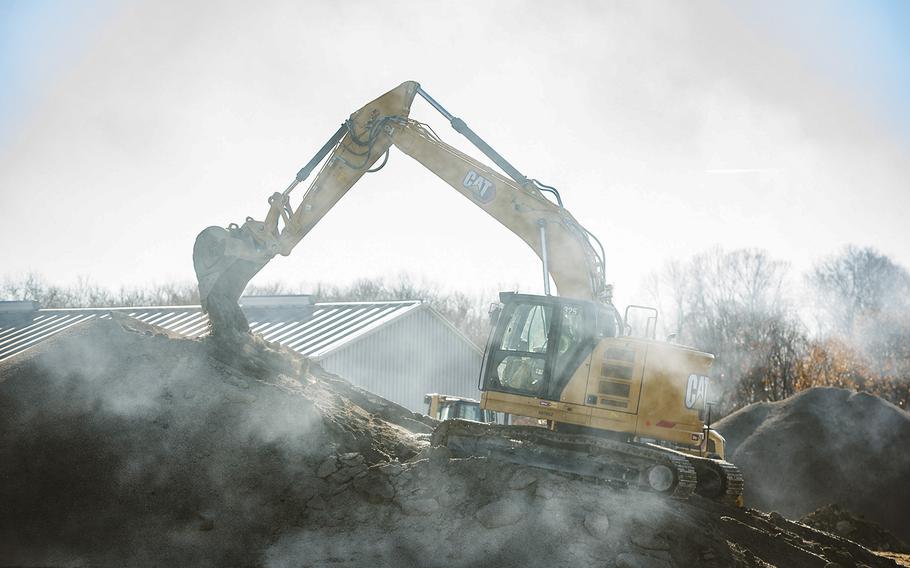
A worker uses an excavator Nov. 21, 2021, to prep a gravel pile at Wright-Patterson Air Force Base, Ohio. The 450-foot trench being dug is part of an Area B construction project designed to help remove substances previously used in firefighting from groundwater. (Hannah Carranza/U.S. Air Force)
DAYTON, Ohio (Tribune News Service) — Nearly two years after it was initially filed, the city of Dayton’s $300 million lawsuit against Wright-Patterson Air Force Base and the Department of Defense over so-called “forever chemicals” sits in legal limbo, blended with thousands of similar lawsuits under a single federal court master docket.
“It was unilaterally transferred to a federal court in South Carolina over a year ago under a statute called ‘multi-district litigation,’” said Stephen Neal Haughey, a Cincinnati attorney representing Dayton in the suit. “It was consolidated with probably 10,000 PFAS cases that are down there.”
“It literally got yanked out,” he added. “We never got a chance to even prove our case.”
The suit finds itself “indefinitely stayed,” as Haughey put it — a precarious position given that newly proposed federal PFAS standards for drinking water make the city’s need for new water treatment funding dollars more urgent, he contends.
The city of Dayton formally filed a drinking water contamination lawsuit against Wright-Patterson and the DOD in early May 2021.
The suit, initially filed in Cincinnati’s federal court, accused the base and the DOD of failing to stop water containing a group of chemicals known as per- and polyfluoroalkyl substances ― or PFAS ― from flowing into the city’s Mad River wellfield. The wellfield is one of several Dayton uses to supply drinking water to more than 400,000 residents in Dayton and Montgomery County.
At the time of the filing, Wright-Patt and defense officials denied the city’s allegations, saying they had followed federal guidelines and were taking an aggressive approach against the chemicals. By the city’s own admission, the base noted at the time, Dayton’s water was safe to drink.
Since the filing, the base has embarked on $26.5 million project to cleanse the chemicals from the ground.
In January, the base said an Army contractor built a 420-foot-long trench near a hazardous materials storage site on the base in an effort to intercept impacted groundwater. A downgradient-collection basin is meant to catch affected surface water so it can be treated before it’s discharged near the Dayton drinking water wellfield, the base also said in January.
The city’s lawsuit sought damages from $10 million to $300 million.
Rose Riley, an Air Force spokeswoman, said the service does not comment on ongoing litigation. A spokeswoman for the 88th Air Base Wing, the unit responsible for security and infrastructure at Wright-Patterson, likewise declined to comment.
Questions were also sent to city of Dayton deputy law director John Musto.
“I don’t know when we will ever have a chance to prosecute our claims and seek relief for the contamination,” Haughey said in a recent interview. “The city is working aggressively to try to find sources of funding at other levels to try to deal with the problem while we sit down there 9,000-plus other complaints in Columbia, S.C.”
The city’s lawsuit was placed with thousands of cases brought by individual plaintiffs, state governments and municipalities like Dayton.
A Judicial Panel on Multidistrict Litigation determined that the cases filed “involved common questions of law and fact such that centralization of the cases was appropriate,” a notice on the South Carolina court’s web site says. “Weighing a number of factors, the Judicial Panel selected the District of South Carolina as the forum for this litigation.”
Judge Richard Gergel oversees discovery and pretrial issues.
Of the thousands of cases, only 28 are complaints against military bases, Haughey said. Most are lawsuits against the manufacturers of PFAS chemicals, such as DuPoint, 3M and others.
“We’re not even a lawsuit against the manufacturers,” Haughey said. “We’re going right after the source of contamination.”
In December, 3M Co. said it will end the production of goods with PFAS chemicals by the end of 2025.
Dayton is not alone in the Miami Valley with its lawsuit. Fairborn and Bellbrook have sued 3M and others, alleging PFAS contamination or potential contamination of community water sources.
In mid-March, the Biden administration said it is proposing the first national drinking water standard for six PFAS chemicals. The EPA is proposing to regulate PFOA and PFOS at a level where the chemicals can be “reliably measured” at 4 parts per trillion.
It’s difficult to say what the future holds for the lawsuit.
“Obviously, the city needs funding to install treatment,” Haughey said. “The U.S. EPA has issued proposed drinking water standards last week (on March 14) that are so low that the city will absolutely need to install treatment to remove PFAS down to the level proposed by the U.S. EPA.”
“We want funding,” the attorney added. “We don’t care how we get it — through litigation, through negotiation, through state and federal funding bills. That’s what the city wants. They don’t want to sue anybody if they (the city) can find funding.”
(c)2023 Springfield News-Sun, Ohio
Visit Springfield News-Sun, Ohio at www.springfieldnewssun.com
Distributed by Tribune Content Agency, LLC.